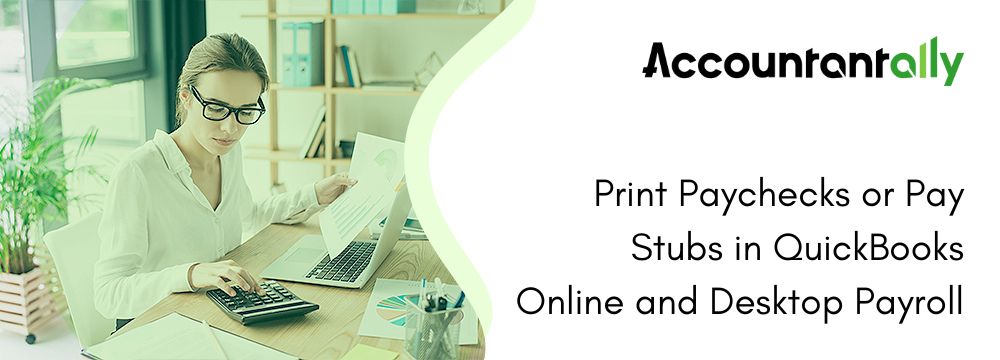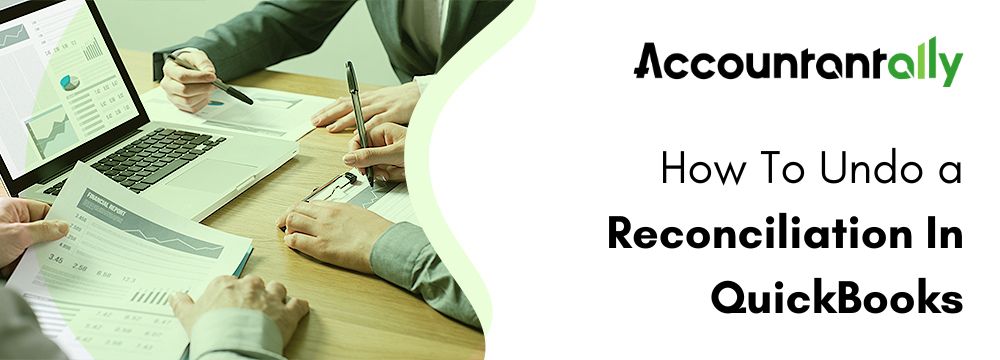Reconciling an account in QuickBooks Desktop is important because it helps to match the bank and credit card statements. To balance your checkbook, you need to review your accounts in QuickBooks and ensure that they tally with real-life credit card and bank statements.
The overall process of reviewing is generally termed as reconciling an account in QuickBooks. When you receive your bank statement, you will need to compare every one of the transactions with the ones that you added to QuickBooks. In the event that everything adds up, your accounts are accurate and balanced. Reconciling QuickBooks with checking, savings, and credit card accounts every month is advised.
In this article, we will be providing the whole set of procedures that can be taken in this section to assist you with the process of reconciling an account in QuickBooks Desktop. Keep in mind that there may be differences in the process for QuickBooks Desktop and Online. As a result, we have attempted to go over both processes in depth.
How to Reconcile an Account in QuickBooks Desktop?
Similar to balancing your checkbook, you must review your accounts in QuickBooks to ensure that they are the same as your real credit card and bank statements. Reconciling accounts in QuickBooks Desktop, such as credit cards, savings, and checking accounts, should be done each month. Compare the list of transactions entered into QuickBooks with your bank statements when you receive them. This ensures that your accounts are accurate and balanced, as long as everything matches.
1st step: Review your opening balance
Prior to beginning the reconciliation, ensure to take a backup of your particular company file. In case you are reconciling an account for the very first time, you need to review the opening balance.
When you prepare a new account in QuickBooks, you need to select a day to begin tracking transactions. You add the real-life bank account balance of whatever day you select. The beginning balance is the opening balance. We suggest setting the opening balance at the beginning of a bank statement. This will in turn make reconciliation very smooth.
2nd step: Prepare for the reconciliation
Make sure to include every transaction for the time of the bank statement that you want to reconcile. Wait to enter any transactions that aren’t on your statement or haven’t cleared your bank yet.
3rd step: Begin your reconciliation
After you get your bank statement, begin your reconciliation.
Choose your earliest bank statement to begin with if you’re reconciling over a number of months. Take one statement at a time and reconcile each month independently.
Note: QuickBooks Desktop will display a sign-in box if it detects that you are not logged in while you are reconciling a Merchant or Payments account. This guarantees that a genuine company ID is successfully linked to your account.- Navigate to the Banking menu
- Now choose Reconcile
- The statement date is filled in automatically. Generally, it is 30 or 31 days after the statement date of the last reconciliation. Alter it as required to match your bank statement.
- QuickBooks also add the Beginning Balance automatically. It accesses the ending balance from your previous reconciliation to acquire this number
- Add the Ending Balance depending on your bank statement
- Add the Service Charge along with the Interest Earned depending on your bank statement. Do not add charges you have added in QuickBooks already
- Review the fields. In case the information is right, choose OK or Continue
In case the beginning balance does not match the statement, need not worry. Certain tools can assist you:
- If your numbers fail to match, choose Locate Discrepancies. This provides you reports you can access to locate irregularities and other reconciliation problems.
- If you need to begin from scratch, you can choose Undo Last Reconciliation.
Note: When a previous reconciliation is undone, the beginning balance returns to the starting balance of your last reconciliation. All cleared transactions on the reconciliation turn unclear.4th step: Compare your QuickBooks and bank statement
To reconcile, just compare the transactions list on your bank statement with that of QuickBooks. Ensure that you have the right transactions and dates. When the reviewing of your statement is complete, you will learn about everything made into QuickBooks.
Before you start,
Here is a set of things you need to do to make your reconciliation smoother:
- If you wish to see transactions only for the statement period you are working on, choose Hide Transaction after the end date of the statement.
- In case you are reconciling a credit card account, the sections are Cash Advances and Charges and Payments and Credits. You need to focus on one single section at one time.
- In case you are reconciling an account for online banking, choose Matched. Next, add the Statement Ending Date from your particular bank statement. This chooses transactions automatically which QuickBooks downloaded and matched.
Note: A matched transaction in the register has a certain lightning bolt near it. Once you reconcile, a lightning bolt replaces it:- In case you wish to sort the list, choose the title or header of a column
- In case there are several transactions in QuickBooks compared to your bank statement, resort the list.
Match your transactions
- When you are all set, begin the first transaction on your bank statement
- Locate the same one in the screen for Reconciliation in QuickBooks
- Now, the two transactions must be compared. In case the transactions match, choose and add a checkmark in the particular checkmark column. This will help to reconcile the particular transaction.
- Every transaction on your system should be compared with the one in QuickBooks. Once you clear the transactions or add transactions to the reconciliation, the Cleared Balance sum decreases. The sum increases in case you add or clear deposits and other credit amounts.
- In case a transaction fails to appear on your statement, make sure it is not marked reconciled. Here are some ways to see if things are matched:
- Look for the Items you’ve marked cleared section to view the total number and amount of transactions you’ve included in the reconciliation. The transaction summary that appears on bank statements is the same for many banks. To check whether any transactions are missing, compare the total number of transactions.
- If you require to change it or acquire more information about a particular transaction, choose the transaction and then double-click it.
- If you wish to take a step back and perform changes to the information you added in Step 3, begin your reconciliation and choose Modify. The service charges, the ending balance information, and interest are displayed in the section beside it.
- When you are at the end, the difference between QuickBooks and bank statements must be USD 0.00. In case it is, Reconcile Now.
What if balances fail to match at the end?
In case the difference is not USD 0.00, you need to worry. QuickBooks offers many ways to do it.
- Return to Reconcile: Navigate back to the reconciliation. This will enable you to review everything again.
- Leave Reconcile: Save the particular reconciliation to enable you to edit or review any existing transactions that trigger problems. You can return and complete the reconciliation later.
- Enter Adjustment: If you wish to complete the particular reconciliation, you can empower QuickBooks to make an adjustment in order to balance everything. You must implement it if you are aware that all of the right transactions are in QuickBooks and that what you added is precise. QuickBooks enters automatically the adjustment as a journal entry.
The journal entry is entered in QuickBooks Desktop under a special expense account named Reconciliation Discrepancies.
Review the reconciliation adjustment
You can see a Previous Reconciliation report for the reconciliation you adjusted to see all of your revisions on the list. This will display cleared transactions as well as any post-transaction modifications that might not be visible in your discrepancy.
- Navigate to the Edit menu and choose Find
- In the Find screen, choose the Advanced tab and then click Memo
- In the Memo field, enter Balance Adjustment and then choose Find
Review cleared transactions
Here are the steps to review all your cleared transactions:
- Navigate to the Reports section and then choose Report Center
- Look and open the last Reconciliation Report
- Choose the account you have reconciled and then either Summary, Detail, or both
- Choose Transactions Cleared and any changes done to such transactions after the reconciliation
- Choose Display
For other kinds of accounts, QuickBooks opens the Make Payment screen. This enables you to enter a bill or write a check to include the outstanding balance. In case you do not wish to record a payment, choose Cancel.
Similar Topic: Fix QuickBooks Bank Reconciliation Error
Final Words
We hope that after reading this article, all your queries regarding the topic of how to reconcile an account in QuickBooks Desktop are cleared now. We have shared all the valuable information regarding the topic.



